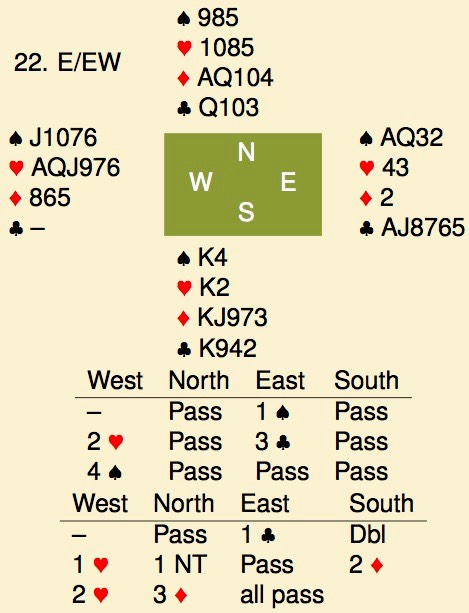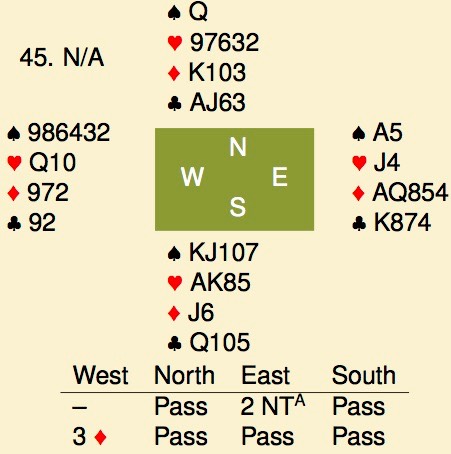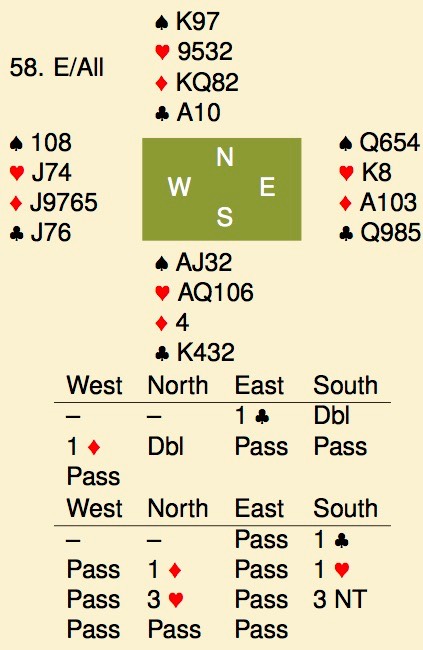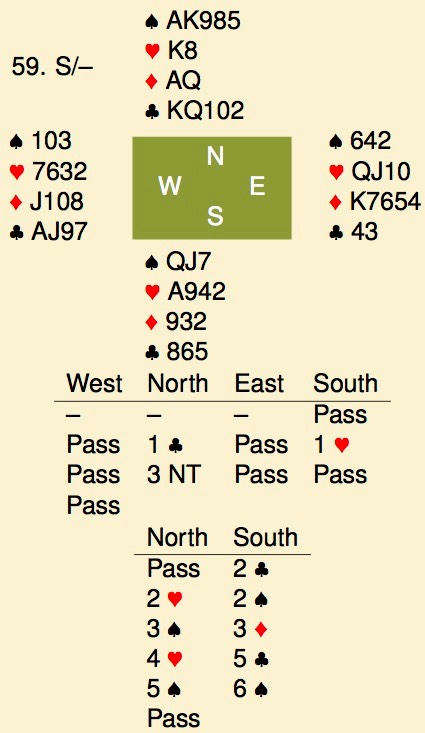We left this match with an 870 point lead in favor of the Italians after 20 boards (for comparison 59-40 in today’s imps). Things calmed down after that, for the next 4 sets, the Italian lead stayed in the 1000 range for most of the next 4 sessions. Of course, points were exchanged, the Italians won mainly by better and more agressive bidding, for example:

In the closed room with Italy EW, a typical example of the Neapolitean club. 1♠ followed by 3♣ showed 4♠ and longer clubs, but was otherwise limited to about 16 points. With 17 or more, he’d opened 1♣. 1♠ immediately uncovered the spade fit. Forquet, west, introduced his heart suit, then bid game. 4♠ is cold on any lead, NS led diamonds, east ruffed the second round, took a heart finesse and a spade finesse, then claimed 11 tricks for +650.
Closed we see 2 things discussed earlier: first an off-shape take-out double by south totally unprepared for a major suit response. South got away with this, this time, as 1NT prevented east from conveniently introducing his spades. Negative doubles had not been invented back then, so west could do little else but repeat his hearts at his second turn, losing the spade fit forever.
3♦ can be defeated on ♠-lead but, following current practice of the time, west lead the ♥A looking for a ruff. That backfired when there was no ruff and the ♥K was set up. +110 to Italy for a gain of +760.

You might think that opening weakish 2 suiters with a 2 level bid, is a recent development but it isn’t. In 1957, Roman club already used 2♥/♠/NT to show weak (11-15) two-suiters with 5 cards in the suit bid (2NT for diamonds) and secondary clubs. The first example came up on board 45.
From a theoretical point of view, I think that these bids were primarily invented to fix a whole in the system, rather than as a preemptive bid. With the canape approach, opening 1♦ and rebidding clubs, shows 4♦ and 5♣ in the same range. Opening 1♣ is not possible, that shows a weak NT or a strong hand (1♣-1♦-2♣ showing 17+ with 4♣ and a second 5+ suit).
Whatever the reason, the Americans didn’t seem to be prepared for this, as they passed throughout despite holding the majority of the high cards and a 9 card heart fit. 3♦ was set 3 tricks, but this was still a gain against the 4♥ contract reached in the other room after a 1♦ opening and take-out double by south. -300 in 3♦ and +650 in 4♥ translated to 350 points for the Italians.

There is, of course, one problem with aggressive bidding and that is that the opponents can double you for penalties. That was a lot easier in 1957, when most doubles at low levels were still for penalties. That happened on board 58.
Closed, 1♣ showed a weak NT or some strong hand. 1♦ was natural and in 1957, north could double this for penalties.
At first, the contract doesn’t look that bad but things quickly changed: spade lead to the ♠J, diamond back to the ♦Q and ♦A. Declarer tried a spade, not that anything else would be much better, won by north. North played a small trump won by west. Declarer now tried a club, won by the ♣A. North played a second club, got a ruff, cashed the ♦K, setting the contract 3 tricks for -800.
In the replay, EW never bid and south ended up playing 3NT after a natural, and sensible, sequence with 3NT offering a choice between 3NT and 4♥. With bad hearts and decent spades, north not reasonably opted for 3NT. ♦6 lead, ♦K, ♦A. ♦10 ducked and a diamond to the ♦Q.
North now has to guess hearts, he got them wrong by leading the ♥2 to the ♥10. West won and cashed 2 more diamonds for down 1.

Some of those points came back on the next board. North, in 3rd seat, faced a rather unusual problem. His hand wasn’t strong enough for a strong 2♣ in their methods, so this would be a simple 1♠ opening. But, this was also the partnership that frequently psyched, and 1♠ not vulnerable in third seat is a perfect psyche for unaware opponents. However, partner was fully aware of their tendencies, and he probably was afraid that 1♠ would be passed out if partner had a few high cards but no real fit. The solution: open 1♣, that has far less chance of being passed out, then jump to game.
This kind of worked. Yes, if I knew that partner frequently psyches in 3rd seat, I’d strongly consider a pass with the south hand too. (Of course, I’m not allowed to know such thing, as the knowledge makes it an illegal agreeement rather than a psyche, but that isn’t the point here.) However, it had the effect of losing the spade fit. 10 tricks made, +430 to the US.
In the other room, north could open 2♣, south made a positive response, 2♠ from north, 3♠ and 6♠ was reached. This looks like down 1, but watch what happened.
♥Q led to the ♥K. For the contract to have a chance, clubs must be 3-3 with the ♣A onside. Declarer thus played the ♠8 to the ♠J, and returned a club. ♣5, ♣7, ♣Q and ♣4. Next the ♠9 to the ♠Q. Note the drop of the ♠10 and the play of the ♠98. ♣6 from the dummy, ♣A, ♣2 and ♣3. West must have missed his partner’s play of the ♣43 or assumed that north held 6 spades, and returned a diamond rather than a club for his partner to ruff. West was, in fact, Charles Goren, generally regarded as the #1 player in the US at that time, so this must not have been too easy.
North now had a second chance. He, correctly, assumed that the ♦K would be offside and went up with the ♦A. Next, he played the carefully preserved ♠5 to the ♠7, drawing the last trump. ♣6 to the ♣10, ♦5 from east. ♣Q, forcing another diamond from east. On the last 2 spades, east (down to ♥J10 and ♦K7) was squeezed.
Nicely played by Chiaradia (north), in particular playing the ♠98 to cross to dummy’s ♠QJ, creating a 3rd entry when the ♠10 dropped. Routinely playing the ♠5 to the ♠Q leaves south an entry short for the squeeze to work even if the ♠10 drops.
Score after 72 boards: +890 in favor of Italy, 162-141. With 152 boards left to play, that is hardly decisive. Things would be about to change soon though.
To be continued.
